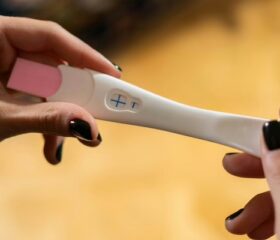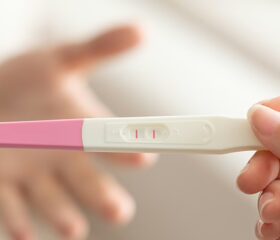What Is the Baking Soda Gender Test, and Is It Accurate?
If you’re eager to learn your baby’s sex as early as possible in your pregnancy, you may have heard that you can find out with a little baking soda. But is the baking soda gender test really worth your time?

The 20-week anatomy scan is when most parents find out their baby’s gender (or, more accurately, their baby’s biological sex). This is a little late for many eager parents, which leads some moms-to-be to look into more unorthodox methods of predicting their babies’ sex.
One popular DIY method you may have seen online is the baking soda gender test. It’s inexpensive, simple, and only requires a few common household items. Unfortunately, despite its popularity, there’s not much evidence that this test actually works.
Read on to learn what the baking soda gender test is and why many parents think it’s a legitimate way to learn what color to paint their nurseries.
What is the baking soda gender test?
The baking soda “gender test” involves mixing your urine with baking soda and observing the reaction. Supposedly, this can predict your baby’s sex.
The theory behind this old wives’ tale is that a fetus alters the acid-base balance (pH level) of a pregnant woman’s urine. Proponents of the test claim that this change in acidity causes an observable reaction when your pee comes into contact with the baking soda. 1
How do you perform the baking soda gender test?
If you want to try out the baking soda gender test, you’ll only need a few household items:
- 1 to 2 tablespoons of baking soda
- A clean, clear glass
- Another clean container to collect your pee
Start off by collecting a sample of your urine. The test’s proponents claim that you should use your first morning pee (as you would with an at-home pregnancy test), since it’s when your urine is most concentrated.
Next, place your baking soda into the clear glass and slowly add a small amount of your pee into it. You’ll then need to monitor it to see how the baking soda reacts.
Interpreting the results
According to proponents of the test, there are two possible outcomes:
- Having a boy: If the baking soda and pee mixture bubbles or fizzes (similar to a freshly poured glass of soda), this supposedly means you’re having a boy.
- Having a girl: If the mixture stays mostly flat and doesn’t fizz much or at all, this supposedly means that you’re having a girl.
Does the baking soda gender test actually work?
Like other kinds of at-home DIY gender predictors, the baking soda gender test doesn’t work.
Your baby’s biological sex doesn’t influence the reaction from mixing your pee with baking soda. This old wives’ tale won’t accurately tell you whether you’re having a boy or a girl. 1
While there’s no harm in trying it out (just for fun), the baking soda gender test is exactly as accurate as a coin toss. You have a 50% chance of it being correct.
The science behind the fizz
The baking soda gender test is nothing more than a simple acid-base chemical reaction.
As you might remember from chemistry class, sodium bicarbonate (baking soda) is a base. When it comes into contact with an acid, it releases carbon dioxide gas, which creates the fizzing and bubbling you see.
According to the folklore behind the test, carrying a boy makes your urine more acidic, which results in the baking soda fizzing. Allegedly, being pregnant with a girl makes your pee more alkaline (less acidic), so it doesn’t react to the baking soda.
However, there is no scientific evidence to support this claim. Your baby’s sex (which is determined by chromosomes at the moment of conception) doesn’t influence the pH of your pee. 1
What actually affects your urine’s pH?
The pH level of your urine can fluctuate significantly throughout the day and during your pregnancy.
Rather than being determined by your baby’s sex, your urine’s pH could change as a result of: 1 2
| High pH (alkaline) | Low pH (acidic) |
|---|---|
| - Kidney failure - Urinary tract infections (UTIs) - A vegetarian diet - Renal tubular acidosis (your kidneys failing to filter acids from your blood) |
- Being dehydrated - A diet high in protein or low in vitamin C - Diabetes mellitus - Nephritis (chronic kidney inflammation) |
Be aware that the pH of your urine can change daily. Eating vegetables before testing your urine could result in it being more alkaline, for instance, whereas eating fish or meat beforehand could lower the pH. 1
Certain pregnancy symptoms might tell you your baby’s sex
While there are plenty of bogus folk tales that (falsely) claim your pregnancy symptoms are signs of whether you’re having a boy or a girl, there may be some truth to a few of them. For instance, there’s research that links having severe morning sickness (hyperemesis gravidarum) to carrying a baby girl. 3
How you can actually find out your baby’s sex
While the baking soda test can be a bit of fun, that’s all it is. You shouldn’t start painting the nursery based on its results.
Fortunately, there are plenty of accurate ways to learn your baby’s biological sex backed by science.
Here are some of the most common ones:
20-week anatomy ultrasound
Most parents find out whether they’re carrying a boy or a girl during their mid-pregnancy ultrasound, with many (incorrectly) calling it the gender scan as a result. You’ll usually get this detailed ultrasound when you’re between 18 weeks and 22 weeks pregnant. 4
- How it works: A trained sonographer will use an ultrasound machine to produce a visual image of your baby. They’ll carefully examine your baby’s developing organs and structures, including her genitals.
- Accuracy: Ultrasounds are very accurate at predicting your baby’s sex, especially when you get them after week 14 of your pregnancy. However, a few factors can affect how accurate your anatomy scan is, such as your baby’s position and the sonographer’s skill.
Noninvasive prenatal testing (NIPT)
If you want to know your baby’s sex earlier, NIPT could give you the answer.
The main goal of this test is to screen your baby’s risk of chromosomal abnormalities, such as Down syndrome (trisomy 21), Edwards syndrome (trisomy 18), and Patau syndrome (trisomy 13). 5
However, as an added bonus, this simple blood test can often tell you whether you’re carrying a boy or a girl as early as 10 weeks into your pregnancy.
- How it works: Your doctor will use NIPT to analyze small fragments of fetal DNA that circulate in your bloodstream. By looking for the presence or absence of the Y chromosome, they will be able to determine your baby’s sex.
- Accuracy: Even though your baby’s sex isn’t what NIPT primarily tests for, it’s very accurate at determining it early on in pregnancy (with a success rate of around 99%). 6
Diagnostic genetic tests
You can also find out your baby’s sex with diagnostic genetic tests like chorionic villus sampling (CVS) and amniocentesis.
Since these procedures are more invasive, your doctor will usually only recommend them if you have a high-risk pregnancy, such as if you’re over 35 or have a family history of genetic disorders.
- Chorionic villus sampling (CVS): You can get this test when you’re between 10 weeks and 13 weeks pregnant. Your doctor will take a small sample of tissue from your placenta for genetic analysis.
- Amniocentesis: Your doctor can perform this procedure between week 15 and week 20 of your pregnancy. It involves collecting a small amount of amniotic fluid from your uterus.
Because both tests analyze your baby’s genetic material, they’re 100% accurate at determining your baby’s sex.
However, both procedures have a small risk of complications, so your doctor will never perform them just to tell you whether you’re having a boy or a girl.
Testimonials of the baking soda gender test
To reiterate, the baking soda gender test isn’t an accurate way of finding out your baby’s sex.
Still, that hasn’t stopped many moms-to-be from trying it out for themselves, all with varying degrees of “success.”
Check out what users on Glow’s Community Forum found when they tried out the baking soda gender test:
- “Yep we did the baking soda and the ring test both said girl and both were right lol!!!”
- “It was right both times for me.”
- “For me it said it was a girl but its a boy”
- “Fizzed like crazy…..but I’m having a girl lol”
- “My sister did it at 12 weeks it said boy, at 20 weeks they confirmed its a boy”
- “I did it and it said girl- I’m having a boy. ;)”
Quotes collected from the following posts on Glow’s Community Forum:
Other old wives’ tales to learn your baby’s sex
The baking soda gender test is just one of many myths that have been passed down through generations.
While none of these are backed by science, they can be a fun way to pass the time until you actually find out your baby’s biological sex.
A few other popular folk methods include:
- Carrying high vs. low: Many women believe that if your baby bump is higher (i.e., positioned higher up in your abdominal region), you’re carrying a girl, whereas carrying low (i.e., lower in your pelvis) means you’re expecting a boy. In reality, how you carry is determined by your muscle tone, body shape, and your baby’s position, not biological sex.
- Your baby’s heart rate: According to this myth, if you’re pregnant with a girl, her heart rate will be above 140 beats per minute (BPM), while a boy will have a heart rate below 140 BPM. 7 However, studies have found that there’s no difference between male and female babies’ heart rates. 8
- Your cravings: Many women start experiencing pregnancy cravings as early as the first trimester. Some moms-to-be claim that what you crave is influenced by your baby’s sex. Allegedly, craving sweets and chocolate means you’re having a girl, while craving salty, sour, or savory foods means you’re expecting a boy. In actual fact, your cravings are more likely related to your changing nutritional needs and hormones, not your growing baby’s sex.
- The Chinese gender predictor chart: This ancient chart uses the mom’s lunar age at conception and the month of conception to predict her baby’s sex. While it’s a fun game to try out, there’s no evidence that it actually works.
Final thoughts
The baking soda gender test, like other DIY gender predictors, isn’t a reliable way of finding out your baby’s sex.
Still, if you’re looking for a fun way to pass the time before you find out for real (and are willing to waste a little baking soda), there’s no harm in trying out the baking soda gender test. Just be sure not to take the results too seriously.
Article Sources
- MedicalNewsToday. "How to do the baking soda gender test" Retrieved October 20, 2025.
- UCSF Health. "Urine pH test" Retrieved October 20, 2025.
- British journal of obstetrics and gynaecology. "Consequences of hyperemesis gravidarum for offspring: a systematic review and meta-analysis" Retrieved October 20, 2025.
- Cleveland Clinic. "20-Week Ultrasound (Anatomy Scan)" Retrieved October 20, 2025.
- Cleveland Clinic. "NIPT Test" Retrieved October 20, 2025.
- Prenatal Diagnosis. "Sex selection and non‐invasive prenatal testing: A review of current practices, evidence, and ethical issues" Retrieved October 20, 2025.
- MedicalNewsToday. "Can a baby's heartbeat predict their sex?" Retrieved October 20, 2025.
- Cleveland Clinic. "Does Baby’s Heart Rate Reveal Their Sex?" Retrieved October 20, 2025.







